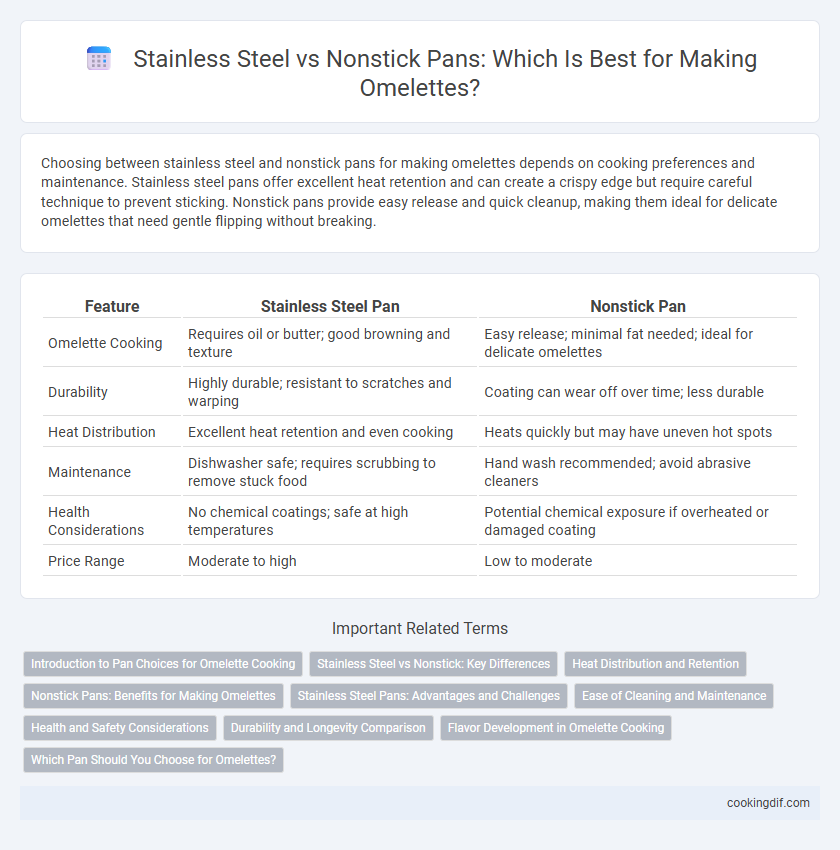Choosing between stainless steel and nonstick pans for making omelettes depends on cooking preferences and maintenance. Stainless steel pans offer excellent heat retention and can create a crispy edge but require careful technique to prevent sticking. Nonstick pans provide easy release and quick cleanup, making them ideal for delicate omelettes that need gentle flipping without breaking.
Table of Comparison
| Feature | Stainless Steel Pan | Nonstick Pan |
|---|---|---|
| Omelette Cooking | Requires oil or butter; good browning and texture | Easy release; minimal fat needed; ideal for delicate omelettes |
| Durability | Highly durable; resistant to scratches and warping | Coating can wear off over time; less durable |
| Heat Distribution | Excellent heat retention and even cooking | Heats quickly but may have uneven hot spots |
| Maintenance | Dishwasher safe; requires scrubbing to remove stuck food | Hand wash recommended; avoid abrasive cleaners |
| Health Considerations | No chemical coatings; safe at high temperatures | Potential chemical exposure if overheated or damaged coating |
| Price Range | Moderate to high | Low to moderate |
Introduction to Pan Choices for Omelette Cooking
Choosing the right pan significantly impacts the texture and ease of cooking an omelette. Stainless steel pans offer excellent heat retention and a durability that withstands high temperatures, allowing for precise browning and searing. Nonstick pans prevent eggs from sticking, enabling effortless flipping and folding, making them ideal for beginners aiming for a smooth, tender omelette.
Stainless Steel vs Nonstick: Key Differences
Stainless steel pans provide superior heat retention and durability, allowing for precise temperature control essential in achieving the perfect omelette texture. Nonstick pans offer effortless release and easier cleanup, reducing the need for excessive oil or butter, which is ideal for low-fat cooking. The choice between stainless steel and nonstick depends on balancing durability and cooking technique preferences for optimal omelette results.
Heat Distribution and Retention
Stainless steel pans offer superior heat distribution and retention, allowing for even cooking and consistent temperature control essential for a perfect omelette. Nonstick pans heat up quickly but may have uneven heat distribution, which can cause inconsistent cooking and affect the omelette's texture. Choosing stainless steel ensures durability and precise heat management, while nonstick prioritizes ease of release and faster heating.
Nonstick Pans: Benefits for Making Omelettes
Nonstick pans offer unparalleled ease in cooking delicate omelettes, preventing sticking and enabling smooth flipping without tearing. Their superior heat distribution ensures even cooking, resulting in fluffy and perfectly textured omelettes every time. Easy cleanup and minimal use of oil or butter contribute to healthier and more convenient omelette preparation.
Stainless Steel Pans: Advantages and Challenges
Stainless steel pans offer superior heat retention and even cooking, making them ideal for achieving a perfectly browned omelette. Their durability and resistance to scratching ensure long-lasting performance without chemical coatings that can degrade over time. However, stainless steel requires proper preheating and oiling to prevent sticking, presenting a learning curve compared to the effortless release of nonstick surfaces.
Ease of Cleaning and Maintenance
Stainless steel pans require thorough cleaning to remove eggs that can stick but withstand abrasive scrubbing without damage, offering long-term durability with proper maintenance. Nonstick pans provide effortless cleaning as food residue lifts easily, reducing time spent on scrubbing; however, they demand gentle handling and specific utensils to maintain their coating and prevent peeling. Choosing between these options hinges on balancing ease of cleaning with upkeep requirements, where stainless steel excels in longevity and nonstick prioritizes convenience.
Health and Safety Considerations
Stainless steel pans offer a non-reactive cooking surface that prevents harmful chemicals from leaching into food, ensuring a safer option for health-conscious cooks. Nonstick pans often contain coatings like PTFE, which can release toxic fumes if overheated above 500degF, posing respiratory risks. Choosing stainless steel reduces exposure to these potential toxins while providing durable, safe cooking for omelettes without compromising nutritional quality.
Durability and Longevity Comparison
Stainless steel pans offer superior durability and longevity for cooking omelettes, resisting scratches, dents, and warping over time better than nonstick options. Nonstick pans, while convenient for easy release, tend to degrade faster due to coating wear and may require replacement every few years. Choosing stainless steel ensures consistent performance and extended lifespan even with frequent use.
Flavor Development in Omelette Cooking
Stainless steel pans promote superior flavor development in omelette cooking by allowing precise temperature control and a natural browning process, enhancing the Maillard reaction and resulting in richer, more complex flavors. Nonstick pans, while convenient for delicate egg release, often limit browning due to lower recommended heat settings, which can lead to a less developed, milder taste. Choosing stainless steel supports optimal caramelization and texture, crucial for gourmet-quality omelettes.
Which Pan Should You Choose for Omelettes?
Stainless steel pans offer superior heat retention and a durable, non-reactive surface that browns eggs evenly but may require more oil to prevent sticking when making omelettes. Nonstick pans provide an effortless release and easy cleanup due to their specialized coating, ideal for delicate omelettes that demand gentle cooking and flipping. Choosing between stainless steel and nonstick pans depends on prioritizing either browning precision and longevity or ease of use and minimal fat usage for perfect omelettes.
Stainless Steel vs Nonstick for pan choice Infographic

 cookingdif.com
cookingdif.com